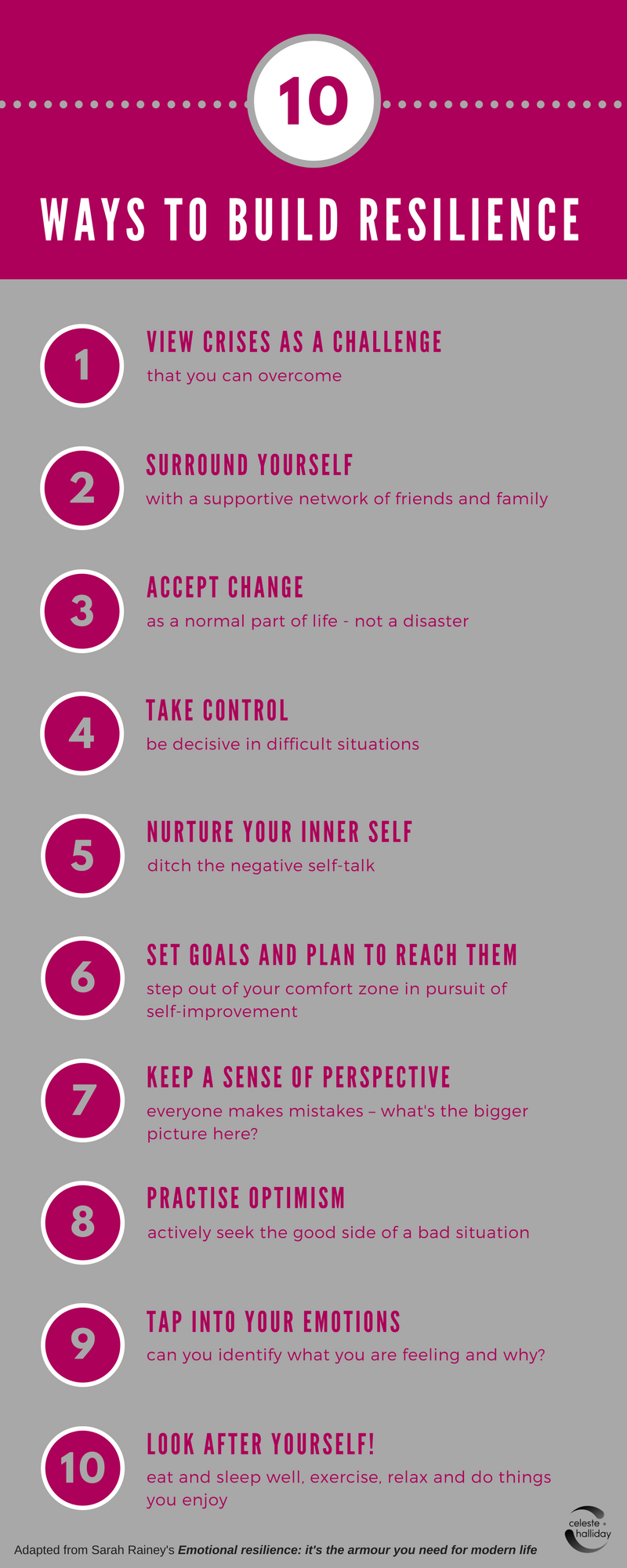If we were playing a game of ‘business buzzword bingo’, I’m pretty sure we’d find ‘resilience’ quite high up on the list. Resilience, like mindfulness, has become ubiquitous – it’s in our work places, our communities and our schools.
We all know we need to become ‘more resilient’, but few of us really understand what it is or how to improve it.
What is resilience?
Resilience is the ability to withstand and bounce back from difficulty. When we are resilient, we know that periods of extreme stress and major life events won’t overcome us. We know we will be able to persevere and come out on the other side, having grown. Sounds good, doesn’t it?
Luckily for us resilience, like most things, is a skill that can be learned
If you take one thing away about resilience, let it be this: our perception equals our reality. Often a difficult period in our lives becomes even more difficult because of the way we think about it. (Don’t get me wrong, horrible and traumatic things happen in all our lives, and I am in no way suggesting we gloss over that or try to put a positive spin on everything.) A powerful tool is the ability to be clear about what is in our control and what is out of our control; we get to choose the meaning we assign to everything that happens to us. We can choose to create a ‘story of resilience’ when faced with challenging situations – our internal narrative will be about how we overcame obstacles, how we learned from the difficulties we faced. The stories we tell ourselves about our lives and experiences – can be the difference between feeling completely overwhelmed and building a resilient mindset.
When faced with difficult times we can roll over or we can rise up. As Christian Moore says in his book The Resilience Breakthrough: “Becoming resilient starts with the realisation that the adversity you experience – any pain, discrimination or challenge – can be converted into powerful fuel that can actually bring opportunity.”
Realistic optimism is the bedrock of bouncing back
One of the key concepts linked to building resilience in times of adversity is developing ‘realistic optimism’.
Optimists are more healthy, recover more quickly from illness, are better at prioritising and adapt more easily to change and challenges. Who doesn’t want more of that? However, there is a caveat – we can’t believe life will be easy, effortless. As Heidi Grant-Halvorson points out in her article 9 Things Successful People Do Differently, we need a healthy dose of realism with our optimism. Believing the road will be rocky means we will be more prepared, we will take action to overcome our obstacles, not be crushed by them.
Peterson et al. (2008) note that: “Resilient individuals are characterised by a staunch view of reality. They are very logical in their interpretations of setbacks — what is in their control, out of their control, and options for taking action.”
A resilience misconception…
Contrary to popular belief, ‘pushing through’ does not help us more resilient.
As detailed by Jim Loehr and Tony Schwartz in their book The Power of Full Engagement: Managing Energy, Not Time, Is the Key to High Performance and Personal Renewal, the opposite is true. If we spend too much time in our ‘performance zone’, we need to make sure we balance it out with more time in our ‘recovery zone’, and the more time we spend in our ‘performance zone’, the more exponentially important the time spent in the ‘recovery zone’ is.
Often, when we feel overwhelmed or are trying to achieve a lot, we think the solution is to put in more hours and, as leaders, we ask our teams to do the same. We know, logically, that overworking is bad for us, bad for business, and is detrimental to the quality of our work – but, traditionally, this what we have learned is the solution to increased demand.
Current research, however, is clear: as we increase the number of hours we work our overall productivity decreases. In fact, it’s energy, not time, that is critical to high performance and to ensure we and our teams have enough energy, we need to focus on how we rest and recover.
In their article Resilience is about how you recharge not how you endure, Michelle Gielan and Shawn Achor note a direct correlation between lack of rest/recovery time – through, for example, sleep disrupted with thoughts of work or having continuous cognitive arousal by watching our phones – and increased health and safety incidents. They estimate it costs companies ’$62 billion a year (billion!) in lost productivity’.
Clearly there’s a legitimate business case for resilience, but if you’re still not convinced a study published by PwC in conjunction with The Mentally Healthy Workplace Alliance showed that programs focused on building a resilient and mentally healthy workplace returned $2.30 for every dollar spent (through lower healthcare costs, higher productivity, lower absenteeism and decreased staff turnover).
When good stress turns bad
There is a point, if you imagine a normal, bell shaped performance curve, where the high performance zone you have been working in tips over and what was good stress, the kind that stretches us to improve, perform and achieve our goals, becomes bad stress, which can lead to burnout and illness.
Gielan and Achor describe resilience as ‘trying really hard, then stopping, recovering, and then trying again’. However, not all ‘recovering’ is equal. They note that: “Rest and recovery are not the same thing. Stopping does not equal recovering.” We may be physically resting, lying on the couch, but if we are still scrolling through our phones or thinking about work, our brain isn’t getting the cognitive break it needs to recover.
We need to strategically stop and focus on taking both a ‘body break’ and a ‘brain break’ – the most often overlooked component, otherwise we risk burnout.
Stop. And get more done
This sounds great in theory, but how do we make the time to ‘strategically stop’?
Gielan and Achor quote the work of Zijlstra, Cropley and Rydstedt who recommend we schedule both ‘internal’ (at work) recovery periods, which are ‘short scheduled or unscheduled relaxation breaks during our work day’, and ‘external’ (to work) recovery periods including weekends, out of work hours and holidays.
Chunking our days into 90 minute periods of focus and then taking a ‘cognitive break’ and ensuring we take a lunch break and focus on something other than work is a good place to start (and will improve our productivity). We also know that switching between tasks can cost us up to 40% of our productivity, so grouping tasks (like email) into one block, can really help us to focus.
Interestingly, people who take all of their paid leave not only ensure adequate ‘external’ recovery periods, but also increase both their productivity and likelihood of promotion. That sounds like a very good reason to book a holiday immediately!
As a leader if you need your team to be more resilient, especially in the face of change, model the behaviour you want to see: show them you are prepared for the unexpected, that you can adapt, step back and look at the bigger picture, and take the time to recover before pushing on again. Here’s 10 things you can start doing today that will make a difference.



